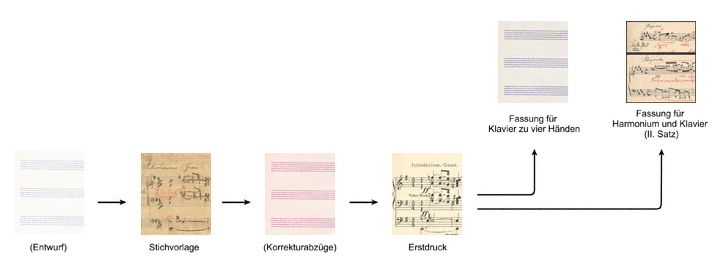Suite in E minor op. 16
for organ
- I. Introduzione – Fuga
- II.
- III. Intermezzo – Trio
- IV. Passacaglia
Den Manen Joh. Seb. Bachs
- -
- -
- Adagio (from Suite e minor op. 16), Version for reed organ and piano
- Suite e-moll op. 16, Version for Klavier zu vier Händen
1.
| Reger-Werkausgabe | Bd. I/2: Phantasien und Fugen, Variationen, Sonaten, Suiten I, S. [2]–36. |
| Herausgeber | Alexander Becker, Christopher Grafschmidt, Stefan König, Stefanie Steiner. |
| Verlag | Carus-Verlag, Stuttgart; Verlagsnummer: CV 52.802. |
| Erscheinungsdatum | Februar 2011. |
| Notensatz | Carus-Verlag, Stuttgart. |
| Copyright | 2011 by Carus-Verlag, Stuttgart and Max-Reger-Institut, Karlsruhe – CV 52.802. Vervielfältigungen jeglicher Art sind gesetzlich verboten. / Any unauthorized reproduction is prohibited by law. Alle Rechte vorbehalten. / All rights reserved. |
| ISMN | M-007-09485-0. |
| ISBN | 978-3-89948-141-9. |
1. Composition
1.1.
A preoccupation with the sonata genre was significant even for Reger’s first major organ work, the Suite in E minor op. 16. He announced the composition he had embarked on as “Sonata for Organ” to the violinist Waldemar Meyer on 30 October 1894: “the same comprises: Introduction and a four-voice triple fugue (E minor), Adagio […] and Passacaglia (E minor)” (Letter). On 16 November he still reiterated the original genre indication to the critic Arthur Smolian, and in a letter of 9 December to the music teacher Anton Gloetzner he referred for the first time to an “organ sonata christened Suite for Organ” – the work was still comprised of three movements at this date.
Work on the composition occupied Reger for several months; only on 23 July 1895 did he write the date of completion with the revealing postscript “Thank God” at the end of the engraver’s copy. The work now comprised four movements.1 Various pieces of evidence indicate that the trio of the third movement was only composed after the beginning of the passacaglia (see engraver’s copy).
2. Publication
2.1.
The Suite in E minor op. 16, which Reger had struggled with for months, appeared in print in March 1896 by Augener & Co. in London. Those whom Reger presented with copies shortly after its publication included Richard Strauss and Johannes Brahms. Brahms accepted the dedication copy, dated 9 April 1896, in an extremely friendly fashion; in due course a short correspondence ensued as well as the exchange of current photographs.
3.
Translation by Elizabeth Robinson.
1. Reception
At present, there are no records of performances in Reger's time.
1. Stemma

2. Quellenbewertung
Der Edition liegt als Leitquelle der Erstdruck zugrunde. Als zusätzliche Quelle wurde die autographe Stichvorlage herangezogen. Die Fassung für Klavier zu vier Händen wurde vor allem bei Fragen der Tonhöhe konsultiert. Von sekundärer Bedeutung ist die Fassung des II. Satzes für Harmonium und Klavier.
3. Sources
Object reference
Max Reger: Suite in E minor op. 16, in: Reger-Werkausgabe, www.reger-werkausgabe.de/mri_work_00017.html, version 3.1.1, 31st January 2025.
Information
This is an object entry from the RWA encyclopaedia. Links and references to other objects within the encyclopaedia are currently not all active. These will be successively activated.